Abstract
Sustainability addresses the need to reduce the structure’s impact on the environment but does not reduce the environment’s impact on the structure. To explore this relationship, this study focuses on quantifying the impact of green roofs or vegetated roofs on seismic responses such as story displacements, interstory drifts, and floor level accelerations. Using an archetype three-story steel moment frame, nonlinear time history analyses are conducted in OpenSees for a shallow and deep green roof using a suite of ground motions from various distances from the fault to identify key trends and sensitivities in response.
1. Introduction
Sustainability addresses the need to reduce the structure’s impact on the environment but does not reduce the environment’s impact on the structure. Given this disconnect, this study brings together the discussion of a sustainable feature, a green roof, and structural resilience to better understand and quantify their relationship. To achieve this objective, nonlinear dynamic analyses for a 3-story green roof structure were conducted for a suite of ground motions to observe the trends in the near, mid-, and far-fault regions with respect to floor displacements, interstory drifts (IDs), and floor level accelerations [1,2,3,4,5].
1.1. Background
Green roofs, also known as living roofs, vegetated roofs, eco-roofs, and roof gardens, are all roofs covered in vegetation ranging from grass to park-like environments with full-sized trees and plants. These roofs do not have potted plants but rather an engineered substrate attached to the structural system which may include filter fabrics, foam insulations, root barriers, a waterproofing membrane, and structural decking [6]. These roofs can be categorized based on the soil substrate’s depth: shallow or deep. Shallow roofs are characterized by lower weight (2.8 kPa) and 5–30.5 cm of soil substrate with vegetation such as grass, sod, or ground cover [7]. In contrast, deep roofs are characterized by higher weight (7.2 + kPa) and over 61 cm of soil substrate with larger vegetation such as full-sized plants, bushes/shrubbery, and even trees [7].
Green roofs date back as far as four thousand years ago with the Hanging Gardens of Babylon. The more conventional use of green roofs resulted from Northern Europe’s concern for the degrading quality of the urban environment in the 1970s. Germany led the way in advancing green roof technology and establishing local and federal legislation resulting in nearly 86 million square meters of living roof today [8] and over 75 European municipalities following in their footsteps [7]. In the United States (U.S.), there is an increased interest in environmental protection with emphasis on sustainability or the coexistence between humans and the environment. According to the U.S. Department of Energy (DOE), between extraction of the resources, manufacturing, construction, and operation, buildings are the major consumer of energy [9]. Various other studies support these findings [10,11]. With this momentum, green roof construction increased by nearly 115% between 2010 and 2011 alone [12]. The historical use and more recent increase in green roofs are rooted in a number of valuable features providing social, economic, and environmental benefits [13,14,15,16,17]. Most notably, green roofs have shown to increase the market value of the structure anywhere between 6% and 15% [12], reduce air-conditioning use/expense nearly by 75% [18], and save over $200,000 in expected costs over its lifetime with two-thirds related to reduced energy needs [19]. Environmentally, green roofs improve storm water retention/management [20,21,22,23], thermal effects [24,25], filter air, and serve as an urban habitat for various species [21]. These benefits have motivated cities across the U.S. including San Francisco, New York, Chicago, and Los Angeles to implement legislative and non-legislative measures encouraging green roof usage [26,27]. Through these efforts, Chicago alone is home to nearly 650,000 square meters of green roofs [28].
Alongside increasing communal concerns arose the U.S. Green Building Council’s Leadership in Energy and Environmental Design (LEED) certification program [17]. This program introduced a way to recognize buildings via a tiered rating system that provided healthy, highly efficient, and cost-saving green buildings. This program grew immensely with the green building movement of the 2000s resulting in 60 registered projects a month in 2000 to nearly 600 projects per month by the end of 2008 and continuing at this level to this day [17]. Green roofs installed on 50% or more of a roof surface can result in 9 points toward LEED certification which is nearly 20% of the total number of points needed to be certified [24]. When speaking about the LEED program, this is a discussion of the importance of sustainability [29,30,31,32] and a means of giving visibility to exemplary buildings. In the structural engineering field, separate from the sustainability movement, discussions of resilient and performance-based design (PBD) to increase the life of a building and its post-event functionality has been developing momentum. Interestingly enough, although discussed separately, a structure’s resilience is crucial for the structure’s sustainable performance.
Resilience entails the turnaround time for a structure to return to functionality after a natural event with these performance objectives dictating the level of allowable damage to the structural system. Programs such as the Resilience-Based Earthquake Design Initiative (REDi) and organizations such as the U.S. Resiliency Council (USRC) are working with engineers and policy makers to develop a system to rank building resilience and hazard performance similar to the way LEED works for sustainability [33,34]. Resilience is firmly based in PBD which considers the building’s use in determining its design which is many times superior to the conventional code-minimum design approach that is independent of performance goals [35,36]. This method quantifies building seismic performance in terms of the 3Ds: death, dollars, and downtime.
Up until very recently, the discussions of green roofs in terms of sustainability and resilience were disconnected. Various researchers have noted the necessity to evaluate seismic hazard as a combined effort between sustainable and resilient design [37,38]. In consideration of the resilience of green roofs, there are number of resources available by cities and organizations such as Ontario Association of Architects, Los Angeles Environmental Affairs Department, and Green Roofs for Healthy Cities, providing various recommendations for wind and fire performance. There are even efforts in the engineering community to develop guidelines with the respective of geotechnical engineering concerns [39,40]. However, within the U.S., there are zero seismic design guidelines or code provisions specified for green roof structures although some efforts have proposed to include provisions related to environmental impacts from seismic hazard damage [41]. The only mention of green roofs in any form of structural discussion is to mention that the extra weight must be accounted for in the selection or retrofit of supporting structural members [7,42,43]. Even with this recommendation, recent catastrophic and fatal failures of green roof systems due to structural failures [44,45,46,47,48] raise questions of whether there is sufficient guidance for designers. The interpretation of the additional weight is left open for interpretation leaving critical gaps in structural design from the basic gravity loading to seismic risk. Several researchers have started to tackle this immense effort as discussed below.
Matta and De Stefano [49] conducted one of the first major numerical studies looking at green roofs and seismic performance by evaluating its use as a tuned mass damper. They isolated the green roof mass using rolling pendulum bearings to create a passive mass-uncertain tuned mass damper pendulum (PTMD) whose behavior is independent of mass. Using this method, the peak interstory drift ratio dropped by 53% with additional reductions observed in the maximum absolute acceleration at the roof level and the base shear. This method showed improvement in seismic performance but deliberately applied a seismic isolation approach to decouple the behavior from the mass uncertainty. In 2009, the same researchers [50] revisited green roofs but took a step back to understand how the seismic response would be altered if the green roof was used as a translational TMD (TTMD) and compared the results against a PTMD. In this study, they determined that the TTMD is capable of achieving substantial reductions of the peak interstory drift ratio especially for large mass ratios (mass of roof to structure above 10–20%) while the PTMD is more suitable for lower mass ratios. With a TTMD, a commercial viscous damper is used to control the amount of damping that is present in the system. In both studies, Matta and De Stefano took a leap in addressing the seismic performance of green roof structures by modifying the green roof to reduce seismic risk before fundamentally understanding the risk distribution.
Around the same time as Matta and De Stefano, work was taking place in New Zealand. Carmody et al. [51,52] conducted an experimental study on a shallow green roof using native ground cover vegetation in New Zealand. They constructed a small-scale one- and three-story green roof structure to investigate the green roof’s ability to reduce the response through increased damping. To achieve this, they attempted to use the green roof as a tuned liquid damper (TLD) which uses water sloshing to dampen movement [53]. Their results showed a 0.2% increase in damping from dry to fully saturated soil for the one-story structure. The three-story structure showed an increase of 0.6% in damping from dry to fully saturated soil. In this case, the study was limited to shallow roofs with attention placed on frequency response data to quantify damping.
More recently, Welsh-Huggins and Liel [54] investigated green building and seismic design from the perspective of a life-cycle analysis. They integrated the discussion of structural, loss, and environmental analysis for a case study concrete 2D-frame located in Los Angeles with and without a green roof. A numerical model was created to model the various green roof structures accounting for the added mass in the column, beam, and reinforcement sizes. All buildings experienced higher peak interstory drift ratios and floor acceleration values at increasing levels of shaking intensity with similar results at the lower levels of shaking. The overall peak responses were then applied into a life-cycle framework to reduce the identified loss objectives.
1.2. Study Approach
The progressive sustainability movement in the U.S. has left little to no time for researchers to actively pursue research considering these features’ resilience. Within this topic, researchers have attempted to initiate the conversation but many times from the perspective of a complex damping system. Welsh-Huggins and Liel took a step back to evaluate the green roof from a more fundamental structural performance perspective within a life-cycle approach. Based on this foundation, the study herein aims to elevate this field of work by: (1) considering the performance of both a shallow and deep green roof; (2) studying the roofs without any additional configuration or device to increase structural performance; (3) analyzing the structural systems for a distribution of motions with variable distance from the fault; and (4) characterizing response trends based on floor level acceleration spectra, displacements, and interstory drifts across the structure’s profile. The ensuing results will present essential information on how green roof’s fundamentally impact the dynamic response of a structure with consideration of its location from the fault. This will highlight key trends and present means of potentially increasing structural resilience through the use of a green roof.
2. Materials and Methods
There were three scenarios considered: control frame (CF), shallow green roof (SGRF), and deep green roof (DGRF). The control building does not have a green roof.
2.1. System Details
The study was conducted using an archetype two-dimensional, three-story, four-bay steel moment frame structure [55] as shown in Figure 1. Each floor measured 3.9 m tall, and each bay measured 9.1 m wide. This structure was derived from a full 3D structure consisting of steel moment frames at each side of the building and intermediate gravity frames. Only the exterior moment frames resist the seismic load. For the soil, it is acknowledged that the soil density changes with the level of saturation. However, based on current industry approach, this study applies a distributed load to the roof level based on the saturated density of the soil. This is 2.8 and 7.2 kPa for a shallow and deep green roof, respectively.

Figure 1.
Three-story steel moment frame with green roof.
2.2. Ground Motions
A suite of ground motions from the PEER database [56] were used for the analyses. Six earthquake events were considered with motions selected at various distances from the fault rupture, ranging from 0 km up to 60 km (Table 1). The near-field is considered 0–15 km, mid-field is 16–44 km, and far-field is any motion recorded over 44 km from the fault rupture. The ground motions were applied uniaxially.

Table 1.
Earthquake ground motions.
2.3. Numerical Modeling
The numerical models and nonlinear dynamic analyses were conducted using OpenSees [57], a finite element program. Columns and beams were modelled using displacement-based beam-column elements. In addition to the green roof loadings applied on the roof floor, typical dead and live loads were accounted for on all levels. The modal information for the three building scenarios is tabulated in Table 2. The control model was verified using modal information available in literature [55]. The inclusion of a green roof increases the fundamental period by 4% and 18% for the shallow and deep scenarios, respectively.

Table 2.
Modal information.
3. Results
Through the nonlinear dynamic analyses, there was a significant amount of information gathered with respect to the structural performance. There were various cases of improved behavior while other responses showed definite limits to the positive impact the green roof can potentially have on the structure. As a result, the following sections discuss each response individually with overall recommendations for green roof use summarized in the Conclusions.
3.1. Maximum Floor Displacements
The maximum displacements showed various trends for the three regions studied. In this study, both the Kobe and Taiwan events resulted in permanent offsets due to nonlinearity in the structure for the 0 km recordings.
3.1.1. Near-Field (NF)
In the NF, the three floors showed similar behavior with the inclusion of the green roof. As seen in Figure 2, below approximately 0.55 g, there is a general decrease in floor displacements with the DGRF. The greatest percentage decrease for the DGRF compared against the CF is at 25% for the roof level, 30% for the 3rd floor, and 32% for the 2nd floor. However, above 0.55 g, the results show a slight increase in the displacements with the addition of the deep green roof. It is only at the highest PGA of 0.86 g that the results once again differentiate themselves with the DGRF decreasing the floor displacements by 5% at the roof floor, 15% at the 3rd floor, and 28% at the 2nd floor. Interestingly, the addition of the DGRF produces the greatest decrease at the 2nd floor below the roof not the roof or the floor directly below it. The SGRF produces minimal variation in the displacements compared against the CF.
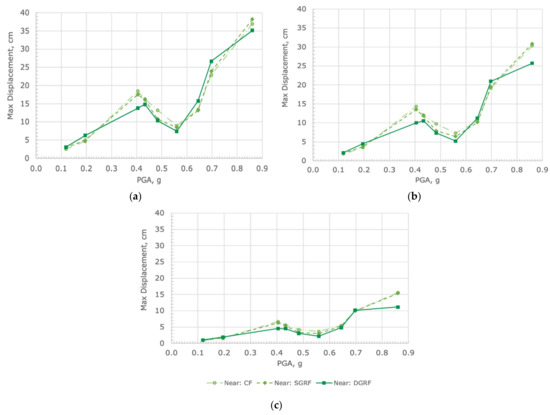
Figure 2.
Maximum floor displacements at (a) roof, (b) 3rd floor, and (c) 2nd floor in the near-field.
3.1.2. Mid-Field (MF)
The results shown in Figure 3 present an interesting contrast to the NF. For a PGA below 0.25 g, the DGRF introduces higher maximum floor displacements for all three floors. This is in contrast to the decrease observed for the NF. Below 0.25 g, there is a 29% and 20% increase in the maximum roof and 3rd floor displacements respectively while the 2nd floor observes a far lower increase. Above 0.25 g, the DGRF reduces the max displacements observed in the roof and 3rd floors while the 2nd floor shows no variation. The differences observed in the MF compared to the NF are also met with some similarities. Firstly, the SGRF shows to have minimal variation to the CF responses. There are points where there are increases and decreases of the displacement but not significant enough to be noted. Secondly, there is a PGA value at which the trends observed change. Lastly, the trends in displacement are generally consistent through the height of the structure. Thus far, these results show there are some very poignant regional trends that can be expected with the use of a DGRF.
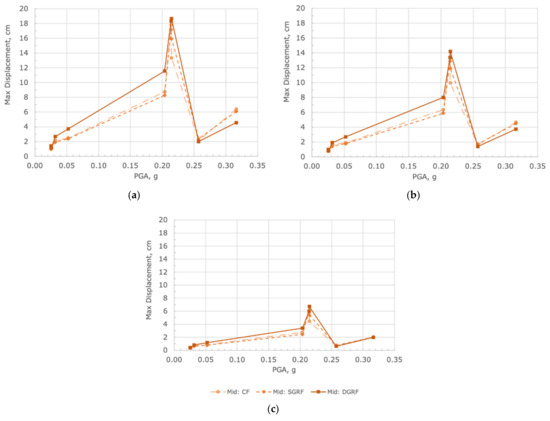
Figure 3.
Maximum floor displacements at (a) roof, (b) 3rd floor, and (c) 2nd floor in the mid-field.
3.1.3. Far-Field (FF)
Figure 4 presents the results in the FF region. Again, there are some very clear trends here to discuss. For events with a PGA below 0.07 g, the response is quite consistent between the CF, SGRF, and DGRF with no significant increases/decreases in the max displacements. At the 0.07 g mark and above, the DGRF stands out as having the ability to decrease the maximum response by nearly 40% at the roof level and almost by half (46% and 48%) at the 3rd and 2nd floors, respectively. These trends again have similarities to the NF and MF regions with a single PGA point of trend change, a region of negligible impact, SGRF showing comparable results to the CF, and most importantly a consistent response through the structure’s height.
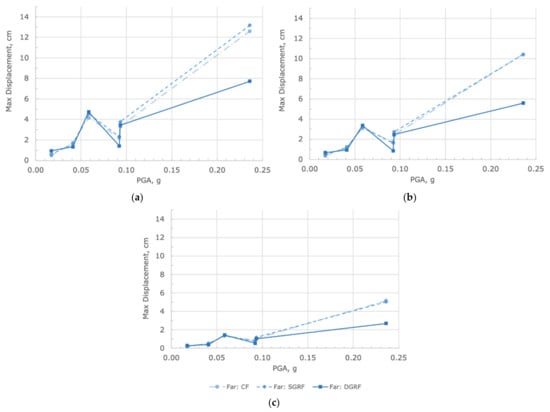
Figure 4.
Maximum floor displacements at (a) roof, (b) 3rd floor, and (c) 2nd floor in the far-field.
Through the floor displacements alone, the DGRF stands out from the other scenarios as it presents opportunities for response improvement under certain conditions. However, this improvement needs to consider the impacts on other responses such as those discussed in the following discussion. Additionally, within a given region, there is a clear dependence on PGA defining which trend will be most probable for the given structure.
3.2. Interstory Drifts (IDs)
For the interstory drifts (IDs), the results are presented as a structural profile to highlight the changes through the structure’s height.
3.2.1. Near-Field (NF)
As noted for the floor displacements, there are several PGA ranges for which observations can be drawn as shown in Figure 5. Starting with the highest PGA motion in Figure 5a, TW00, this motion distinguishes itself the most from the other profiles. The DGRF introduces a 30% increase in the roof ID but then reduces this same response in the lower floors with the greatest decrease occurring on the 2nd floor at 28%.
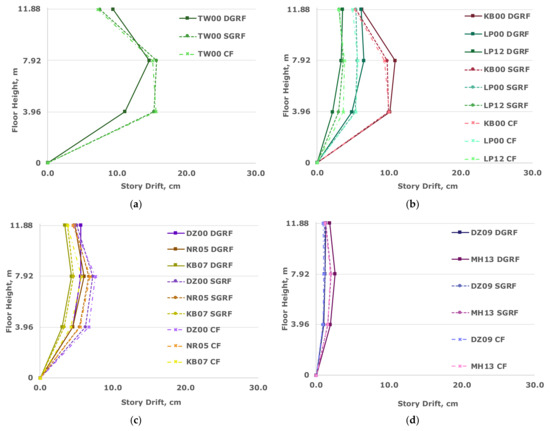
Figure 5.
Near-fault interstory drift profile for (a) PGA = 0.86 g, (b) PGA = 0.55g–0.85 g, (c) PGA = 0.4g–0.54 g, and (d) PGA < 0.4 g.
The next results (KB00, LP00, and LP12) in Figure 5b have PGA between 0.55 g and 0.86 g. The DGRF presents incremental increases in the roof IDs. The other two floors show a maximum 41% decrease at the 2nd floor and a 16% increase on the 3rd floor for the DGRF. The SGRF, on the other hand, clearly shows very similar drifts to the CF with some floors seeing negligible increases or decreases for the various events.
In Figure 5c, these motions (DZ00, NR05, and KB07) have moderate ranges of PGA with nearly similar trends throughout. At the roof level, the ID changes very little with the presence of the SGRF or DGRF. In the 2nd and 3rd floors, the DGRF clearly shows the ability to decrease the IDs with the magnitude of decrease varying with motion. The SGRF, however, again shows responses very similar to the CF. Finally, Figure 5d presents the lowest PGA events in the NF. In this case, the presence of a green roof makes minimal difference as all the scenarios produce IDs throughout the structure’s profile that are nearly comparable to the CF. From these Figures, although all these motions are in the NF, the roof’s impact on the IDs is highly dependent on the level of PGA the structure experiences.
3.2.2. Mid-Field (MF)
The results shown in Figure 6 present ID profiles for MF region. Similar to the NF, several PGA ranges for MF regions were identified from which observations can be drawn. Above 0.25 g, there is a decrease in the maximum IDs with the DGRF up to 32% at the 3rd floor and an insignificant decrease at the 2nd floor. However, the roof observes a maximum increase in ID of 41%. For PGA between 0.21 g and 0.24 g, the DGRF demonstrates greater IDs for all floors, but the SGRF shows the greatest increase in IDs of 21% at the 2nd floor.
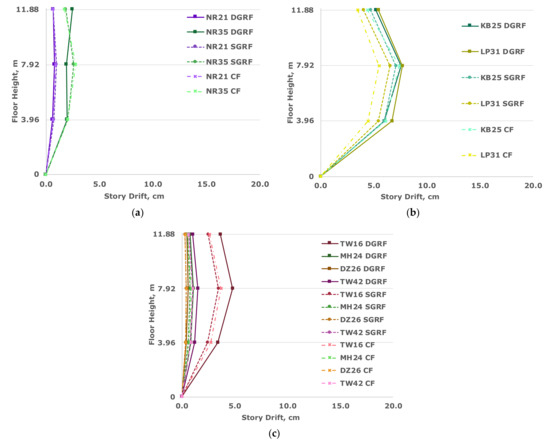
Figure 6.
Mid-fault interstory drift profile for (a) PGA > 0.25 g, (b) PGA = 0.21g–0.24 g, and (c) PGA < 0.21 g.
Generally, in the PGA range below 0.21 g, DGRF exhibits increased IDs at all floor levels with the highest increase (71%) at the roof level. However, even though the percent increase may seem significant, the interstory drifts are small. The greatest drift is observed for TW16 and is below 3 cm. The rest of the GMs in this range have interstory drifts that are below 1 cm for the CF. The addition of the shallow green roof does not result in significant changes. One more interesting result to note is that in the MF region, the greatest IDs occur in the PGA range between 0.21 g and 0.24 g. As a result, even though there were some significant increases and decreases in the IDs above this PGA the actual magnitude of influence is minimal.
3.2.3. Far-Field (FF)
Figure 7 presents the results in the FF region. For the FF region, interstory drifts are falling well within the allowable story drift requirements. Above 0.07 g, the DGRF improves the response for the lower floors—the IDs decrease by 42% for the 3rd story and by 48% for the 2nd story. As can be seen on the Figure 7, for the ground motions below 0.07 g the response does not deviate much from the CF with the addition of shallow or deep green roof. Although the percent difference for the DGRF as compared to CF may seem significant, the drifts in the FF region are fairly small and range from a little over 5 cm to less than a centimeter.
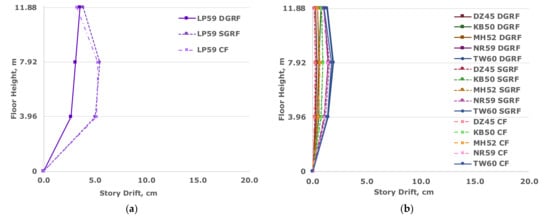
Figure 7.
Far-fault interstory drift profile for (a) PGA > 0.07 g and (b) PGA < 0.07 g.
3.3. Dynamic Coupling
Nonstructural damage to equipment can be the defining point between a facility being operable and not operable. With this in mind, it is crucial to expand consideration of performance beyond structural response to include nonstructural content as well. To understand the level of analysis required, using a criterion by Chen and Wu [58], coupled equipment-structure-interaction is checked as applied on comparable equipment [59]. Equipment-structure interaction is the phenomenon where not only does the primary structure’s (e.g., main building) seismic response influence the performance of the secondary system (e.g., equipment) but a reverse influence can occur as well.
In this study, a broader consideration of potential machinery/equipment is considered for this check. As part of Chen and Wu’s approach, there are two parameters of consideration: Rm and Rw. Rm is a mass ratio of the equipment mass to the structural mass. Rw is an angular frequency ratio of the equipment to the structure and can be calculated for various modes. For the primary structure, Table 2 is used along with consideration of the three mass scenarios (control, shallow, and deep green roof). For the equipment, extreme ends of potential mass and frequency are considered. A HVAC system, for example, is one of the heaviest pieces of equipment that can be incorporated into the structure. A 98 kN HVAC system results in Rm values of 0.0010 (CF), 0.0009 (SGRF) and 0.0008 (DGRF). For equipment, this content is relatively stiff with periods far below 1s producing Rw values as small as 0.17 and as large as the charted maximum of 3. Using this information, as shown in Figure 8, all scenarios lie within the highlighted region showing coupling is not required.
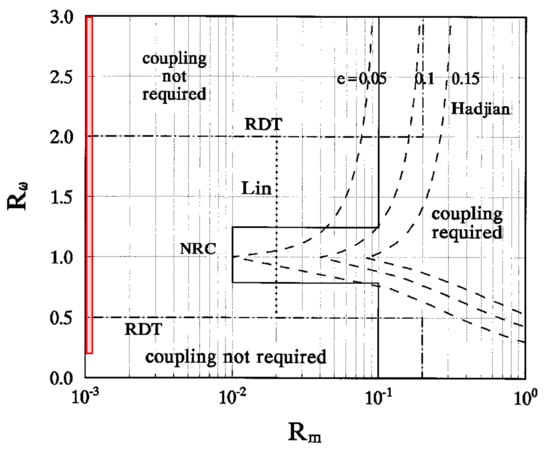
Figure 8.
Dynamic coupling criteria (based on Chen and Wu [58]).
3.4. Floor Response Spectra
Floor response spectra (FRS) provide a means to understand the acceleration demand at a specific floor level as well as define seismic design forces for nonstructural components [60,61,62,63,64]. These plots are significant because they provide insight into the acceleration demands impacting the contents of the structure. In many cases, equipment and machinery are acceleration sensitive making this response a metric of defining operational performance post-event. The exact limits of equipment will not be discussed but rather broadly analyzed in terms of frequency ranges. In this study, given the number of motions used, the median floor response spectra at the roof and 3rd floor are calculated per [65].
3.4.1. Roof
The roof level is a traditional site for housing key HVAC and mechanical equipment. It is assumed that although the green roof is expected to take the majority of the available acreage on this floor, this floor would continue to house certain essential equipment due to its ideal environment and space availability. To provide the best insight into the response for this study’s scenario, the spectra are grouped in two different ways: roof scenario and location.
Starting with Figure 9, the median FRS are grouped based on the roof scenario. The median spectra are calculated using all of the motions (All) and then based on motions related to distance from the fault (e.g., Near-Fault, NF). For all three roof scenarios, there are two locations of peak acceleration centered around the first and second modes. Notably, the local and overall maximum accelerations for each scenario are approximately equivalent. At the roof level, this identifies two period ranges for which acceleration should be a parameter of concern for equipment. This potentially impacts both short-period equipment as well as systems closer to a period of 1 s.
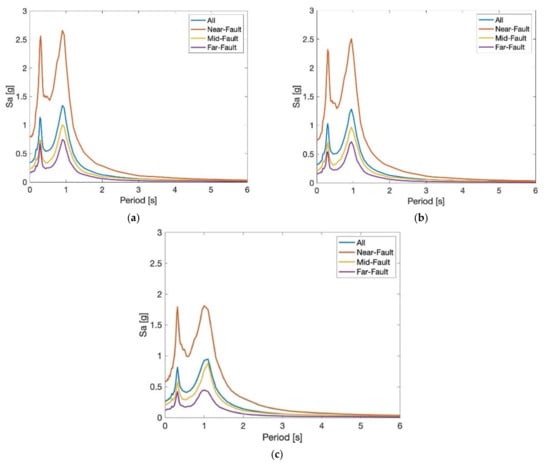
Figure 9.
Median roof floor response spectra for all distances from fault grouped based on roof scenario: (a) Control, (b) Shallow, and (c) Deep.
Comparing the CF and SGRF, there is minimal difference in response with a maximum decrease of 10% for all locations. On the other hand, the DGRF experiences a decrease of approximately 30% for all distances from the fault with a broadening of the spectral peak around the fundamental mode of the system for the NF and FF site locations. (These result trends can be clearly observed at distances from the fault in Figure 10). Thus, the increase in weight due to the SGRF, is not significant enough to make a substantial difference. The DGRF, however, is capable of not only reducing floor level accelerations but changing the spectral shape.
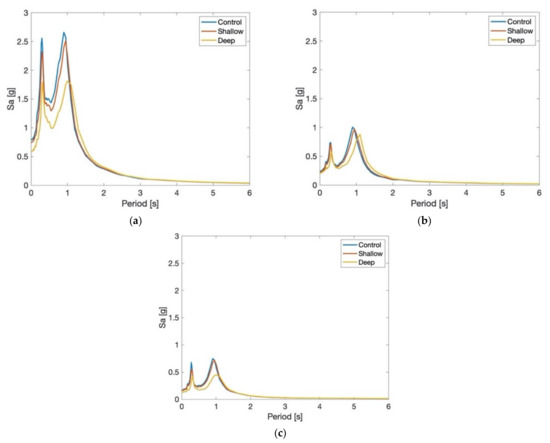
Figure 10.
Median roof floor response spectra for all roof scenarios grouped based on distance from fault: (a) Near-field, (b) Mid-field, and (c) Far-field.
The implementation of a green roof can have positive effects to the seismic response depending on the type of equipment and machinery anticipated at the roof level. Given that the majority of equipment falls in the 0.1–1 s (1–10 Hz) period range, the DGRF does not remove the period range for amplified response but it does reduce the level of maximum probable acceleration compared to the CF or SGRF scenarios. In addition to equipment/machinery, it is important to note that green roofs require an irrigation system. Each roof has a different approach to irrigating the plants given the space and practicality for water storage. A long period water tank at the roof level will not be detrimentally impacted by a green roof unless the tank’s fundamental period falls closer to 1 s. The control system along with all green roof scenarios have low acceleration values for all periods above 1.5 s.
The final result to observe and discuss from this set of figures is the use of the overall or All motion median spectrum. The CF and SGRF All spectra fall in between the MF and NF responses with it being a closer match to the MF with a small percentage of over-estimation. For the DGRF, the All spectrum coincides very well with the MF. Given this fact, it is important to acknowledge that an All spectrum cannot fully capture the expanse in response that can be observed. These results show that although the All spectrum closely estimate the MF results, this does not work well as a metric for the NF or FF regions. Thus, even for the control scenario, the median spectrum should be calculated for each respective region.
3.4.2. 3rd Floor
To understand how the green roof can potentially impact the floor response at a non-green roof level, the 3rd floor or the floor directly beneath the green roof is next observed.
In Figure 11, the median spectra for the 3rd floor with some various clear differences are compared to the roof results. Although there still appears two peaks centered around the first and second modes, the magnitude of acceleration at these peaks is no longer approximately the same value. Instead, for the CF and SGRF, there is an overall maximum peak floor acceleration value around the 1s mark with a 10% decrease in acceleration for the 0.3 s peak. For the DGRF, there is an interesting change in the spectral shape as the DGRF achieves an overall maximum around the second mode (approx. 0.3 s). This presents the case that the DGRF is capable of decreasing floor accelerations by approximately 40% for all distances from the fault for systems of periods around 1 s. However, given this shift in overall peak acceleration, the DGRF then leads to a 33% increase in floor accelerations for lower periods. The peak of the DGRF spectra around 1 s again shows some broadening similar to the roof spectra. Similar to the roof results, in comparing the CF and SGRF, there is minimal difference between their performance with a maximum decrease of 10% for the NF spectrum. (This result trend can be clearly observed at distances from the fault in Figure 12). All other regions for the SGRF show little to no change in the accelerations compared to the CF. Similar to the roof results, the CF and SGRF All spectra fall in between the MF and NF responses with it being a closer match to the MF with a small percentage of over-estimation. For the DGRF, the All spectrum coincides very well with the MF.
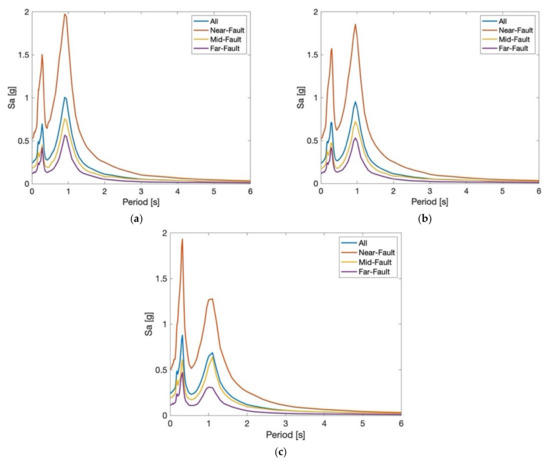
Figure 11.
Median 3rd floor response spectra for all distances from fault grouped based on roof scenario: (a) Control, (b) Shallow, and (c) Deep.
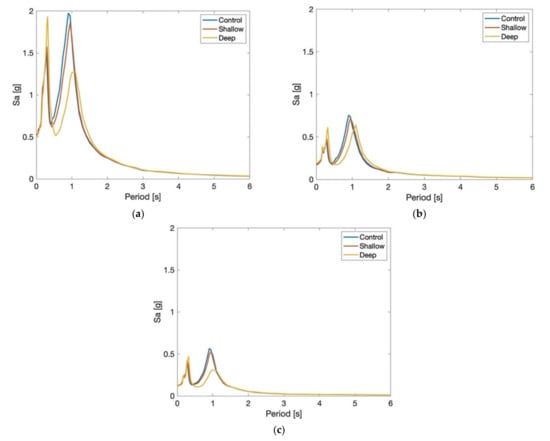
Figure 12.
Median 3rd floor response spectra for all roof scenarios grouped based on distance from fault: (a) NF, (b) MF, and (c) FF.
4. Conclusions
As engineers and communities become more aware of how the man-made structures can influence the environment, there will be a need to embrace new features with attention to how we can maximize their usage. With this in mind, this study establishes that green roofs, especially those with deep soil substrates, can be advantageous to the structural and nonstructural performance of a system. Shallow roofs perform very similarly to the control frame. As a result, minimal positive or negative interference can be expected from their additions. However, the use of a deep green roof with a more park like environment can be far more influential.
By examining the floor displacements and IDs, there were various trends observed showing sensitivity to region and PGA. In every fault region, there were PGA values that served as changing points in the trends. For the NF, below 0.55 g, the responses observed decreased with the DGRF with the greatest reductions occurring in the 2nd floor. Above this PGA, the displacements decreased, however, the IDs actually experienced an increase which was most notable in the floor directly below the roof. In the MF, these results changed as the lower PGA motions actually observed increased displacements and IDs. However, the greatest impact was not on a lower floor but the roof itself. The higher PGA events produced lower responses in all floors but again the roof experienced the greatest reduction. In the FF, the responses decreased substantially for higher PGA motions, however, the general magnitude of these responses were smaller due to their distance away from the fault rupture. The displacements and IDs, experienced various changes in the trends in each region.
With coupling not required for equipment-structure interaction, the floor response spectra provided insight into potential seismic design forces of the nonstructural components. Again, the shallow roof did not produce a significant change in the results compared to the control. However, the deep roof presented more interesting results. At the roof level, the DGRF produced a nearly uniform 30% decrease in probable floor accelerations at all distances from the fault. There was a broadening of the spectral peaks, but this result was promising as it reduced the floor accelerations in the lower period range where the majority of equipment falls. This result, however, must be considered along with the fact that this very same roof can actually drastically increase the floor accelerations in the floor directly below. With a 33% increase in the lower periods, this shows that careful consideration of the nonstructural layout should be accounted for in the design. This same floor does experience a 40% decrease around a period of 1 s which suggests the potential for optimizing nonstructural placement.
Overall, the inclusion of a green roof is a positive contribution to a structure. The increased structural performance will serve as an additional benefit to the usage of green roofs in structures aiming to include sustainable elements. Resilience can be improved as well but under careful consideration of the structure’s function and identification of key/essential equipment and machinery. Through the deliberate placement of this nonstructural content, the inclusion of a green roof for more critical infrastructure can potentially serve as a means of increasing seismic resilience. As more studies explore new sustainable features, there is an opportunity to not only reinforce their usage but further promote them to increase both resilience and sustainability.
Author Contributions
Conceptualization, J.W.; methodology, J.W. and S.T.; formal analysis, J.W. and S.T.; investigation, J.W. and S.T.; data curation, J.W. and S.T.; writing—original draft preparation, J.W. and S.T.; writing—review and editing, J.W.; visualization, J.W. and S.T.; supervision, J.W.; project administration, J.W.; funding acquisition, J.W. All authors have read and agreed to the published version of the manuscript.
Funding
This research received no external funding.
Institutional Review Board Statement
Not applicable.
Informed Consent Statement
Not applicable.
Data Availability Statement
The data presented in this study are available on request from the corresponding author. The data are not publicly available due to connection to acquisition of external funding efforts.
Acknowledgments
We would like to acknowledge and express our gratitude for the internal support provided by SFSU for this project.
Conflicts of Interest
The authors declare no conflict of interest.
References
- Beilic, D.; Casotto, C.; Nascimbene, R.; Cicola, D.; Rodrigues, D. Seismic fragility curves of single storey RC precast structures by comparing different Italian codes. Earthq. Struct. 2017, 12, 359–374. [Google Scholar] [CrossRef]
- Filiatrault, A.; Sullivan, T. Performance-based seismic design of nonstructural building components: The next frontier of earthquake engineering. Earthq. Eng. Eng. Vib. 2014, 13, 17–46. [Google Scholar] [CrossRef]
- Nascimbene, R. Numerical Model of a Reinforced Concrete Building: Earthquake Analysis and Experimental Validation. Period. Polytech. Civ. Eng. 2015, 59, 521–530. [Google Scholar] [CrossRef]
- Sullivan, T.J.; Calvi, P.M.; Nascimbene, R. Towards improved floor spectra estimates for seismic design. Earthq. Struct. 2013, 4, 109–132. [Google Scholar] [CrossRef]
- Taghavi, S.; Miranda, E. Response Assessment of Nonstructural Building Elements; PEER Report 2003/05; University of California: Berkeley, CA, USA, 2003. [Google Scholar]
- National Roofing Contractors Association. The NRCA Green Roof Systems Manual; National Roofing Contractors Association: Rosemont, IL, USA, 2007. [Google Scholar]
- Peck, S.; Kuhn, M. Design Guidelines for Green Roofs; Ontario Association of Architects: Ottawa, ON, Canada, 2003. [Google Scholar]
- Dinardo, K. The Green Revolution Spreading Across Our Rooftops. The New York Times, 9 October 2019. [Google Scholar]
- United States Department of Energy. 2011 Buildings Energy Data Book; D&R International Ltd.: Silver Spring, MD, USA, 2012.
- Junnila, S.; Horvath, A. Life-cycle environmental effects of an office building. J. Infrastruct. Syst. 2003, 9, 157–166. [Google Scholar] [CrossRef]
- Thormark, C. Energy and resources, material choice and recycling potential in low energy buildings. In Proceedings of the International CIB Conference SB07 Sustainable Construction, Materials and Practices, Lisbon, Portugal, 12–14 September 2007. [Google Scholar]
- GBA. Green Roofs. Where All People Can Thrive. Available online: www.go-gba.org/resources/green-building-methods/green-roofs/ (accessed on 6 June 2020).
- Dunnett, N.; Nagase, A.; Hallam, A. The dynamics of planted and colonizing species on a green roof over six growing seasons 2001–2006: Influence of substrate depth. Urban Ecosyst. 2008, 11, 373–384. [Google Scholar] [CrossRef]
- Hutchinson, D.; Abrams, P.; Retzlaff, R.; Liptan, T. Stormwater Monitoring Two Ecoroofs In Portland, Oregon, USA; Greening Rooftops for Sustainable Communities: Chicago, IL, USA, 2003. [Google Scholar]
- MacMullan, E.; Reich, S.; Puttman, T.; Rodgers, K. Cost-benefit evaluation of ecoroofs. In Proceedings of the 2008 International LID Conference, ASCE, Seattle, WA, USA, 16–19 November 2008. [Google Scholar]
- Stovin, V.; Dunnett, N.; Hallam, A. Green roofs-getting sustainable drainage off the ground. In Proceedings of the 6th NOVATECH International Conference of Sustainable Techniques and Strategies in Urban Water Mangement, NOVATECH, Lyon, France, 25–28 June 2007; pp. 11–18. [Google Scholar]
- United States Green Building Council. LEED Credit Library. LEED BD+C: v4.1—LEEDv4.1; United States Green Building Council: Washington, DC, USA, 2020. [Google Scholar]
- Liu, K.K.Y.; Baskaran, B.A. Thermal performance of extensive green roofs in cold climates. In Proceedings of the 2005 World Sustainable Building Conference, Tokyo, Japan, 27–29 September 2005. [Google Scholar]
- Gerrity, J.; Hall, K.; Leasia, J.; Rogers, D.; Stanley, L.; Van Epps, C. Green Roofing at the University of Michigan Final Report; University of Michigan: Ann Arbor, MI, USA, 2012. [Google Scholar]
- Vijayaraghavan, K. Green roofs: A critical review on the role of components, benefits, limitations and trends. Renew. Sustain. Energy Rev. 2016, 57, 740–752. [Google Scholar] [CrossRef]
- Carson, T.B.; Marasco, D.E.; Culligan, P.J.; McGillis, W.R. Hydrological performance of extensive green roofs in New York City: Observations and multi-year modeling of three full-scale systems. Environ. Res. Lett. 2013, 8, 024036. [Google Scholar] [CrossRef]
- DiGiovanni, K.; Gaffin, S.R.; Montalto, F.; Rosenzweig, C. Low Impact Development (LID) Technologies for Sustainable Stormwater Management: Green Roofs. In Proceedings of the 2010 Watershed Management Conference: Innovations in Watershed Management under Land Use and Climate Change Location, Madison, WI, USA, 23–27 August 2010. [Google Scholar]
- DiGiovanni, K.; Montalto, F.; Gaffin, S.; Rosenzweig, C. The applicability of classical predictive equations for the estimation of evapotranspiration from urban green spaces: Green roof results. J. Hydrol. Eng. 2013, 18, 99. [Google Scholar] [CrossRef]
- Gaffin, S.R.; Imhoff, M.; Rosenzweig, C.; Khanbilvardi, R.; Pasqualini, A.; Kong, A.Y.Y.; Grillo, D.; Freed, A.; Hillel, D.; Hartung, E. Bright is the new black—multi-year performance of high-albedo roofs in an urban climate. Environ. Res. Lett. 2012, 7, 014029. [Google Scholar] [CrossRef]
- Susca, T.; Gaffin, S.R.; Dell’Osso, G.R. Positive Effects of Vegetation: Urban Heat Island and Green Roofs. Environ. Pollut. 2011, 159, 2119. [Google Scholar] [CrossRef]
- Wang, J.W.; Poh, C.H.; Tan, C.Y.T.; Lee, V.N.; Jain, A.; Webb, E.L. Building biodiversity: Drivers of bird and butterfly diversity on tropical urban roof gardens. Ecosphere 2017, 8, e01905. [Google Scholar] [CrossRef]
- San Francisco Planning. Better Roofs. Available online: https://sfplanning.org/project/better-roofs (accessed on 12 June 2020).
- City of Chicago. Chicago Planning and Development. Chicago Sustainable Development Policy Handbook. Available online: https://www.chicago.gov/city/en/depts/dcd/supp_info/sustainable_development/chicago-sustainable-development-policy-handbook0.html (accessed on 12 June 2020).
- Green Roofs and LEED Certification. LEED and Green Roofs. Available online: https://www.greenrooftechnology.com/leed/leed_Greenroofs (accessed on 12 June 2020).
- Berke, P.R. Natural hazard reduction and sustainable development: A global assessment. J. Plan. Lit. 1995, 9, 370–382. [Google Scholar] [CrossRef]
- Bokalders, V.; Block, M. The Whole Building Handbook; Earthscan: London, UK, 2010. [Google Scholar]
- Schwab, A.K.; Brower, D.J. Sustainable Development and Natural Hazards Mitigation; Division of Emergency Management: Raleigh, NC, USA, 1999. [Google Scholar]
- Almufti, I.; Willford, M. REDi Rating System: Resilience-Based Earthquake Design Initiative for the Next Generation of Buildings; Arup: London, UK, 2013. [Google Scholar]
- USRC. Available online: http://www.usrc.org/ (accessed on 12 June 2020).
- Porter, K.A. An Overview of PEER’s Performance-based Earthquake Engineering Methodology. In Proceedings of the Ninth International Conference on Applications of Probability and Statistics in Engineering, San Francisco, CA, USA, 6–9 July 2003. [Google Scholar]
- Moehle, J.; Deierlein, G.G. A framework methodology for performance-based earthquake engineering. In Proceedings of the 13th World Conference on Earthquake Engineering, Vancouver, BC, Canada, 1–6 August 2004. Paper No. 679. [Google Scholar]
- Welsh-Huggins, S.J.; Liel, A.B. Integrating green and resilient building design for enhanced disaster recovery. In Proceedings of the 3rd International Conference on Urban Disaster Reduction, Earthquake Engineering Research Institute, Boulder, CO, USA, 28 September–1 October 2014. [Google Scholar]
- Welsh-Huggins, S.J.; Liel, A.B. Integrating hazard-induced damage and environmental impacts in building life-cycle assessments. In Proceedings of the 2014 International Symposium of Life-Cycle Civil Engineering, Tokyo, Japan, 16–19 November 2014. [Google Scholar]
- Kraupa, T.J.; Mason, H.B.; Stuedlein, A.W.; Higgins, C. Characterization of ecoroofs and ecoroof soils. In Proceedings of the GeoCongress 2014, Geotechnical Special Publication 234: Geo-Characterization and Modeling for Sustainability, Atlanta, GA, USA, 23–26 February 2014; p. 3571. [Google Scholar] [CrossRef]
- Kraupa, T.J.; Stuedlein, A.W.; Mason, H.B.; Higgins, C.C. Engineered Ecoroof Systems: Geotechnical Considerations. ASCE J. Infrastruct. Syst. 2016, 22. [Google Scholar] [CrossRef]
- Court, A.; Simonen, K.; Webster, M.; Trusty, W.; Morris, P. Linking next-generation performance-based seismic design criteria to environmental performance (ATC-86 and ATC-58). Struct. Congr. 2012, 2012, 922–928. [Google Scholar] [CrossRef]
- Permitting Guide for Green Roofs, City of Berkeley Green Building Initiative. 2011. Available online: https://www.cityofberkeley.info/uploadedFiles/Planning_and_Development/Level_3_ (accessed on 12 June 2020).
- United States, Congress, Environmental Affairs Department. Green Roofs—Cooling Los Angeles, A Resource Guide; United States, Congress, Environmental Affairs Department: Washington, DC, USA, 2006.
- Weiler, S.K.; Scholz-Barth, K. Green Roof Systems; Wiley: Hoboken, NJ, USA, 2009. [Google Scholar]
- Gromala, D.S.; Kapur, O.; Kochkin, V.; Line, P.; Passman, S.; Reeder, A.; Trusty, W. Natural Hazards and Sustainability for Residential Buildings; FEMA P-798; FEMA: Washington, DC, USA, 2010. [Google Scholar]
- Fountain, H. Green Roof Collapses in Illinois. New York Times, 18 February 2011. [Google Scholar]
- Baltic Course. Latvia: Civil Engineer Sergets Sentenced to Six Years in Jail for Zolitude Store Collapse. 2020. Available online: http://www.baltic-course.com/eng/legislation/doc=154160 (accessed on 12 June 2020).
- Global Post. Design Fault Likely Caused Latvia Roof Cave-In; Global News Enterprises LLC: Boston, MA, USA, 2013. [Google Scholar]
- Matta, E.; De Stefano, A. Robust design of mass-uncertain rolling-pendulum TMDs for the seismic protection of building. Mech. Syst. Signal Process. 2007, 23, 127–147. [Google Scholar] [CrossRef]
- Matta, E.; De Stefano, A. Seismic performance of pendulum and translational roof-garden TMDs. Mech. Syst. Signal Process. 2009, 23, 127–147. [Google Scholar] [CrossRef]
- Carmody, M.O.; Jasarevic, M.; Omenzetter, P.; Clifton, G.C.; Fassman, E.A. Seismic Response of Green Roofs. In Proceedings of the 2009 New Zealand Society for Earthquake Engineering, Auckland, New Zealand, 4–5 September 2009. [Google Scholar]
- Carmody, M.O. Seismic Response of Green Roofs; Department of Civil and Environmental Engineering, University of Auckland: Auckland, New Zealand, 2009. [Google Scholar]
- Reed, D.A.; Yeh, H.; Ju, H.; Yu, J.; Gardarsson, S.M. Performance of Tuned Liquid Dampers under Large Amplitude Excitation. J. Wind Eng. Ind. Aerodyn. 1998, 74–76, 923–930. [Google Scholar] [CrossRef]
- Welsh-Huggins, S.J.; Abbie, L.B. A Life-Cycle Framework for Integrating Green Building and Hazard-Resistant Design: Examining the Seismic Impacts of Buildings with Green Roofs. Struct. Infrastruct. Eng. 2016, 13, 19–33. [Google Scholar] [CrossRef]
- McCallen, D.; Larsen, S. NEVADA—A Simulation Environment for Regional Estimation of Graound Motion and Structural Response; UCRL-ID-152115; Lawrence Livermore National Lab: Livermore, CA, USA, 2003. [Google Scholar]
- Ancheta, T.D.; Darragh, R.B.; Stewart, J.P.; Seyhan, E.; Silva, W.J.; Chiou, B.S.J.; Wooddell, K.E.; Graves, R.W.; Kottke, A.R.; Boore, D.M.; et al. PEER 2013/03-PEER NGA-West2 Database; Pacific Earthquake Engineering Research Center: Berkeley, CA, USA, 2013. [Google Scholar]
- McKenna, F.; Fenves, G.L. Open System for Earthquake Engineering Simulation; University of California: Berkeley, CA, USA, 2000. [Google Scholar]
- Chen, G.; Wu, J. Transfer-Function-Based Criteria for Decoupling of Secondary Systems. J. Eng. Mech. 1999, 125, 340–346. [Google Scholar] [CrossRef]
- Bardopoulos, F.; Papagiannopoulos, G.; Pnevmatikos, N. Design considerations for photovoltaic panel arrays made from aluminum: A case study. Steel Constr. 2020, 13, 52–60. [Google Scholar] [CrossRef]
- United States Nuclear Regulatory Commission. Regulatory Guide 1.122; United States Nuclear Regulatory Commission: Rockville, MD, USA, 1978.
- Pinkawa, M.; Hoffmeister, B.; Feldmann, M. Floor Response Spectra Considering Influence of Higher Modes and Dissipative Behaviour. In Seismic Design of Industrial Facilities; Klinkel, S., Butenweg, C., Lin, G., Holtschoppen, B., Eds.; Springer: Wiesbaden, Germany, 2014. [Google Scholar] [CrossRef]
- Vukobratovic, V.; Fajfar, P. Floor spectra for analysis of acceleration-sensitive equipment in buildings. In Proceedings of the International Conference on Earthquake Engineering and Structural Dynamics, Reykjavik, Iceland, 12–14 June 2017. [Google Scholar]
- Haymes, K.; Sullivan, T.; Chandramohan, R. Developing Procedures for the Prediction of Floor Response Spectra; University of Canterbury: Christchurch, New Zealand, 2018. [Google Scholar]
- Gabbianelli, G.; Perrone, D.; Brunesi, E.; Monteiro, R. Seismic Acceleration and Displacement Demand Profiles of Non-structural Elements in Hospital Buildings. Buildings 2020, 10, 243. [Google Scholar] [CrossRef]
- Baker, J.W.; Cornell, C.A. Which Spectral Acceleration Are You Using? Earthq. Spectra 2006, 22, 293–312. [Google Scholar] [CrossRef]
Publisher’s Note: MDPI stays neutral with regard to jurisdictional claims in published maps and institutional affiliations. |
© 2021 by the authors. Licensee MDPI, Basel, Switzerland. This article is an open access article distributed under the terms and conditions of the Creative Commons Attribution (CC BY) license (https://creativecommons.org/licenses/by/4.0/).